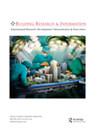Affinity towards flexible housing – a study among homeowners in Germany
IF 3.7
3区 工程技术
Q1 CONSTRUCTION & BUILDING TECHNOLOGY
引用次数: 0
Abstract
ABSTRACT Uncertain rental and real estate prices, demographic changes and the diversity of household types are increasing pressure on the housing market. One way of dealing with these challenges is flexible housing, which is designed to adapt to changing needs and patterns, both social and technical. It enables buildings to be used for longer periods, which increases their long-term sustainability by reducing not only their material and energy consumption but also the level of environmental pollution. The aim of this study is to examine to what extent criteria of flexible housing are relevant to homeowners and which factors can be used to predict the importance. By conducting an online survey of 519 homeowners in Germany, we were able to identify ten factors that can be used to predict the perceived importance of flexible housing. These are the number of rooms in the property, the size of the residential area, the household size, homeowner’s age, environmental awareness, importance to the homeowner of stability and longevity, accessibility, value stability, use of renewable materials and recyclability of construction materials. This study contributes to literature by identifying criteria for flexible housing from the homeowner’s perspective. It is the first study to analyse this question empirically.对弹性住房的喜爱——德国房主的一项研究
不确定的租金和房地产价格、人口结构的变化以及家庭类型的多样性正在增加住房市场的压力。应对这些挑战的一种方法是灵活的住房,它旨在适应不断变化的社会和技术需求和模式。它使建筑能够使用更长的时间,这不仅降低了材料和能源消耗,还降低了环境污染水平,从而提高了建筑的长期可持续性。本研究的目的是检验灵活住房的标准在多大程度上与房主相关,以及哪些因素可以用来预测其重要性。通过对德国519名房主进行在线调查,我们确定了可以用来预测弹性住房重要性的十个因素。这些是房地产中的房间数量、住宅区的大小、家庭规模、房主的年龄、环境意识、对房主稳定性和寿命的重要性、可达性、价值稳定性、可再生材料的使用和建筑材料的可回收性。这项研究从房主的角度确定了灵活住房的标准,为文献做出了贡献。这是第一个对这一问题进行实证分析的研究。
本文章由计算机程序翻译,如有差异,请以英文原文为准。
求助全文
约1分钟内获得全文
求助全文
来源期刊

Building Research and Information
工程技术-结构与建筑技术
CiteScore
8.60
自引率
7.70%
发文量
43
审稿时长
>12 weeks
期刊介绍:
BUILDING RESEARCH & INFORMATION (BRI) is a leading international refereed journal focussed on buildings and their supporting systems. Unique to BRI is a focus on a holistic, transdisciplinary approach to buildings and the complexity of issues involving the built environment with other systems over the course of their life: planning, briefing, design, construction, occupation and use, property exchange and evaluation, maintenance, alteration and end of life. Published articles provide conceptual and evidence-based approaches which reflect the complexity and linkages between cultural, environmental, economic, social, organisational, quality of life, health, well-being, design and engineering of the built environment.
 求助内容:
求助内容: 应助结果提醒方式:
应助结果提醒方式:


